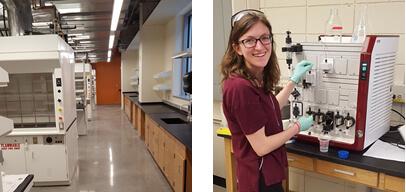The Ph.D. program in chemistry remains one of the larger graduate programs on campus with 40 students typically enrolled.
During their first two years at the University of Vermont, graduate students develop a deep understanding of chemistry through a series of advanced courses offered by chemistry faculty. In later years, graduate students represent the heart of the department’s research enterprise and will soon benefit from the cutting-edge facilities in the new STEM complex. In addition, by providing high-quality teaching assistants, the chemistry Ph.D. program allows the department to offer a world-class B.S. degree with comprehensive laboratory offerings.
The chemistry Ph.D. program draws students from all corners of the United States and international locations such as China, Iran, and Nepal. This diverse group of students is attracted by the outstanding research programs at UVM, and the welcoming environment of Burlington.
Recruiting the best and brightest group of graduate students to Burlington from all over the globe has innumerable benefits for the UVM community and the state of Vermont. UVM chemistry Ph.D. students make essential contributions to the vast majority of scholarly publications by the department, which have totaled 88 journal articles and book chapters in the last two years!
To choose just one example, UVM chemistry graduate students Dan Bercovici, Nezar Al-Bataineh, Ramya Srinivasan, and Ram Dhakal recently published an article in the Journal of the American Chemical Society under the guidance of Prof. Matthias Brewer. Based upon isotopic labeling, and computational analysis, the research team was able to elucidate the mechanism of a novel carbon–hydrogen insertion reaction. This insight was critical because it will enable researchers to design new chemical reactions.
UVM chemistry graduate students have also disseminated their important research findings at several conferences in recent years. Earlier this year, Ariel Schuelke-Sanchez gave an oral presentation describing her research findings to an international audience at the Bioinorganic Chemistry conference in California. Under the guidance of Prof. Matt Liptak, Ariel has figured out how to coax new reactivity out of a recombinant enzyme she has expressed in Escherichia coli. This recombinant enzyme catalyzes the insertion of cobalt into a ring-shaped molecule called porphyrin. These findings have important implications for our fundamental understanding of metal trafficking in biological system.
As might be expected, the success of UVM chemistry Ph.D. students continues after graduation. The vast majority of newly minted Ph.D.s transition directly into academic, government, and industrial research positions. For example, Rebecca Harvey received her Ph.D. in 2015 as a member of Prof. Giuseppe Petrucci's laboratory for her research with atmospheric aerosols. She has gone on to a prestigious post-doctoral appointment with Prof. Paul Shepson at Purdue University, a globally recognized leader in the measurement of atmospheric methane (and other greenhouse gases) using airborne platforms.
